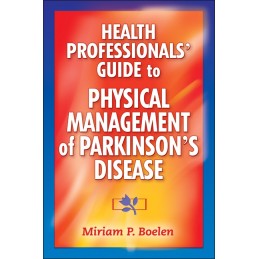- Reduced price

Order to parcel locker

easy pay


 Delivery policy
Delivery policy
Choose Paczkomat Inpost, Orlen Paczka, DHL, DPD or Poczta Polska. Click for more details
 Security policy
Security policy
Pay with a quick bank transfer, payment card or cash on delivery. Click for more details
 Return policy
Return policy
If you are a consumer, you can return the goods within 14 days. Click for more details
Parkinsons disease, the most prevalent hypokinetic movement disorder, is expected to occur with increasing frequency among aging populations worldwide. While we await the discovery of a cure, combining physical interventions with traditional medical interventions can significantly improve overall quality of life. Health Professionals Guide to Physical Management of Parkinsons Disease fills a void in this area of clinical management by comprehensively addressing the physical management of Parkinsons disease in a single volume.
Written for clinicians, Health Professionals Guide to Physical Management of Parkinsons Disease will prove to be a useful resource for physical therapists as well as other health care professionals who manage patients with Parkinsons disease. The text expertly distills and blends diverse research-based sources with the authors own extensive clinical experience. The result is a concise manual that provides not just the science but also the clinical application necessary in the selection of physical interventions.
The text begins with an introduction to Parkinsons disease and the umbrella of care required in the management of patients, giving readers a clear explanation of medicinal, surgical, assisted, and self-management strategies depending on the stage of disease. After laying this groundwork, the text continues by focusing on two types of dyskinetic movements:: dystonia (which can influence posture) and tremor. Also reviewed is the use of supportive devices and adaptive equipment to minimize the effects of dystonia and tremor. The discussion moves on to balance deficits (Hoehn and Yahr stage 3), transfer problems, and the neurologic and musculoskeletal impairments that contribute to them. The text concludes with a qualitative and quantitative assessment of gait and includes specific treatment guidelines addressing characteristic gait problems.
Health Professionals Guide to Physical Management of Parkinsons Disease is an easy-to-navigate reference for clinicians who do not have the time or the need to read a book cover to cover, but want answers fast. The chapters are written as independent units extensively cross-referenced, and they can be read in any order. Throughout the text, readers will find clinical decision trees, flow charts, and sample forms to guide their selection of intervention strategies. The book contains many user-friendly features::
-Numerous illustrations demonstrate exercise considerations, evaluative techniques, and guidance on implementing interventions.
-The 11 reproducible handouts address safety and compensatory strategies to improve mobility in patients.
-Access to a variety of patient help features—including case examples specific to chapter topics and instructions for handling problems—engage readers and put answers within fingertip reach.
With new research showing exercise to be beneficial in delaying the onset of the physical impairments caused by Parkinsons disease, this is a timely resource that will make clinical practices more productive, improve patient outcomes, and advance the treatment of patients with Parkinsons disease.
Data sheet
Part I. General Issues
Chapter 1. Introduction to Parkinsons Disease and Its Physical Management
Distinguishing Features of Idiopathic Parkinsons Disease and Secondary Parkinsonism
Guidelines for Physical Management
Chapter 2. Medical and Surgical Interventions
Medications
Challenges of Parkinsons Disease
Deep Brain Stimulation
Chapter 3. Exercise and Rehabilitation Considerations
Flexibility
Resistance Training
Cardiorespiratory Endurance
Lifelong Self-Maintenance
Chapter 4. Equipping Caregivers
Caregiver Burden and Educational Needs
Resources for Caregivers
Part II. Dyskinesia
Chapter 5. Postural Variations and Dystonia
Camptocormic Posture
Drop-Head Posture
Ankle and Foot Dystonia in PD
Chapter 6. Tremors
Essential and Resting Tremors
Physical Management of Tremors
Part III. Balance
Chapter 7. Postural Instability
Definitions
Postural Control Strategies
Evaluation of Postural Stability
Interventions for Postural Instability
Stepping Strategy
Chapter 8. Balance Evaluation
Parkinsons Disease Fall Risk Factors
Balance Evaluation and Treatment
Part IV. Transfers
Chapter 9. Chair Transfers
Activity Analysis
Chair Transfer Kinematic Patterns
Evaluation of Chair Transfers
Therapeutic Interventions
Chapter 10. Bed Mobility
Bed Mobility Assessment
Therapeutic Interventions
Chapter 11. Floor Transfers
Successful Floor Transfers
What to Do After a Fall
Part V. Gait
Chapter 12. Gait Deviations and Instability
Interventions for Gait Deviations
Examination of and Interventions for Gait Instability
Gait Velocity
Chapter 13. Compensatory Strategies for Gait Interventions
Rhythmic Auditory Stimulation (RAS)
Attention Strategies
Visual Cues
Chapter 14. Freezing
General Issues in Freezing
Evaluating Freezing
Freezing Interventions
Chapter 15. Turning While Ambulating
Factors Contributing to Turning Instability
Evaluating Turns
Interventions to Improve Turns
Chapter 16. Walkers, Canes, and Footwear
Matching Walkers to Patients
Canes
Footwear
Appendix A. Rating Scales and Questionnaires
Appendix B. Tests
Appendix C. Documentation
Appendix D. Patient Handouts and Interventions
